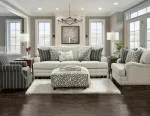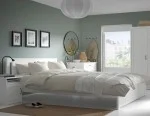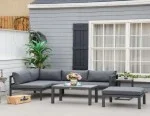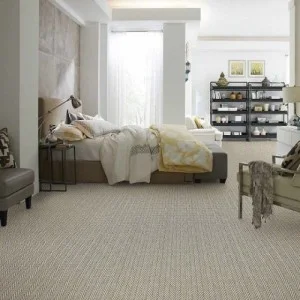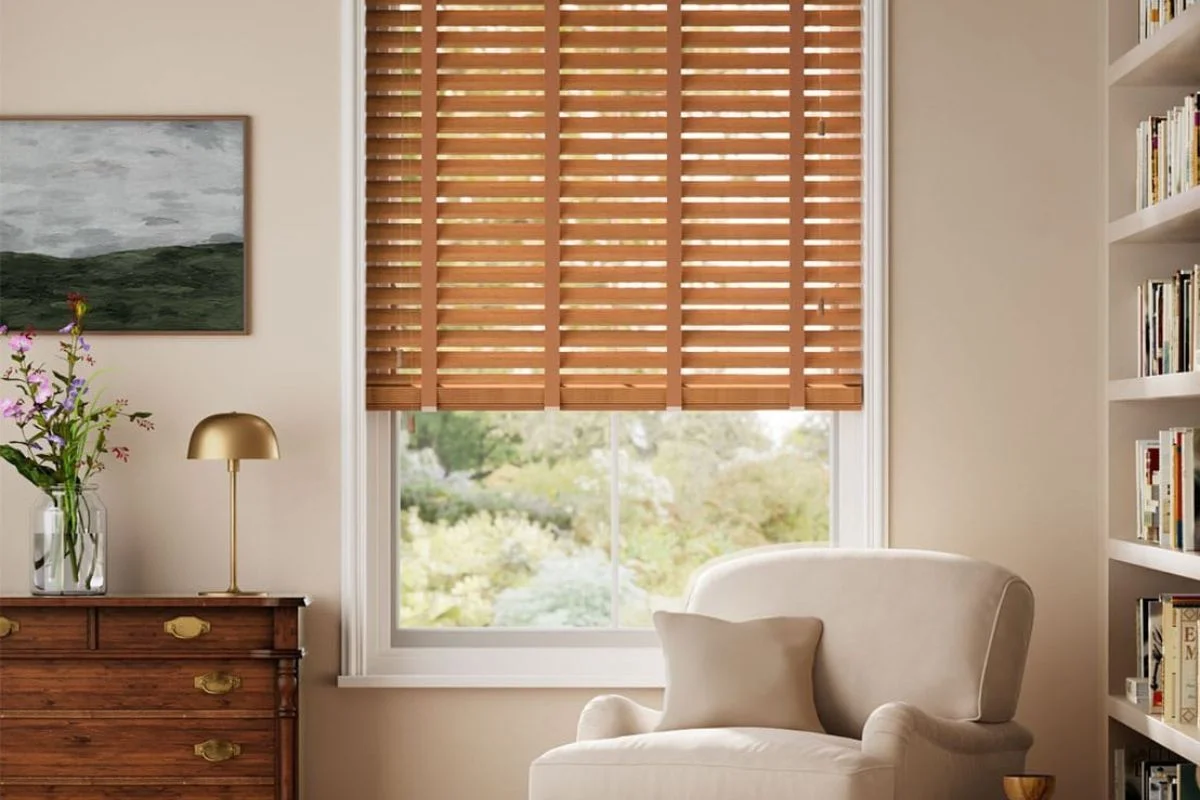 Wooden blinds have long been a staple in interior design, offering a timeless elegance and natural warmth to any space. As we delve into the world of window treatments, it’s fascinating to witness how wooden blinds continue to evolve, adapting to modern aesthetics while retaining their classic charm. In this exploration of design trends and inspirations for wooden blinds, we embark on a journey through the latest innovations, styles, and creative applications that showcase the versatility of this beloved window covering. From contemporary twists on traditional designs to bold statements in texture and color, wooden blinds offer endless possibilities for elevating the ambiance and functionality of any room. Join us as we uncover the latest trends shaping the world of wooden blinds, drawing inspiration from nature, architecture, and emerging design movements. Whether you’re seeking inspiration for a fresh new look or simply intrigued by the endless design possibilities, this guide is your invitation to discover the beauty and versatility of wooden blinds in today’s interiors. Let’s explore the exciting world of wooden blinds and unlock the potential to transform your living spaces into havens of style, comfort, and sophistication.
Wooden blinds have long been a staple in interior design, offering a timeless elegance and natural warmth to any space. As we delve into the world of window treatments, it’s fascinating to witness how wooden blinds continue to evolve, adapting to modern aesthetics while retaining their classic charm. In this exploration of design trends and inspirations for wooden blinds, we embark on a journey through the latest innovations, styles, and creative applications that showcase the versatility of this beloved window covering. From contemporary twists on traditional designs to bold statements in texture and color, wooden blinds offer endless possibilities for elevating the ambiance and functionality of any room. Join us as we uncover the latest trends shaping the world of wooden blinds, drawing inspiration from nature, architecture, and emerging design movements. Whether you’re seeking inspiration for a fresh new look or simply intrigued by the endless design possibilities, this guide is your invitation to discover the beauty and versatility of wooden blinds in today’s interiors. Let’s explore the exciting world of wooden blinds and unlock the potential to transform your living spaces into havens of style, comfort, and sophistication.Brief Overview of Wooden Blinds as a Popular Window Treatment Option:
Wooden blinds stand out as a timeless and versatile window treatment choice, adored for their natural beauty, functionality, and ability to enhance the aesthetics of any space. Crafted from high-quality wood materials such as basswood, bamboo, or faux wood, these blinds offer a combination of elegance, durability, and practicality that has made them a preferred choice among homeowners and interior designers alike. Wooden blinds boast a classic appeal that seamlessly complements a variety of interior decor styles, from traditional to modern and everything in between. Their warm tones and rich textures add depth and character to any room, creating a welcoming and inviting atmosphere. One of the key advantages of wooden blinds lies in their ability to provide superior light control and privacy. With adjustable slats, homeowners have the flexibility to regulate the amount of sunlight entering their spaces while maintaining desired levels of privacy throughout the day. Moreover, wooden blinds offer excellent insulation properties, helping to regulate indoor temperatures and reduce energy costs year-round. By effectively blocking out heat in the summer and retaining warmth in the winter, wooden blinds contribute to a more comfortable and energy-efficient living environment. Another notable feature of wooden blinds is their durability and longevity. Constructed from sturdy wood materials, these blinds are built to withstand daily wear and tear, making them a worthwhile investment for long-term use. In addition to their functional benefits, wooden blinds are available in a variety of finishes, stains, and slat sizes, allowing homeowners to customize their window treatments to suit their unique preferences and decor schemes.Benefits of Wooden Blinds
Wooden blinds offer a range of benefits that make them a popular choice for homeowners and designers seeking both style and functionality in window treatments. From their natural beauty to their practical features, wooden blinds provide numerous advantages that set them apart from other window treatment options. Here are some key benefits of choosing wooden blinds: Natural Beauty: Wooden blinds exude a timeless elegance and warmth that adds character to any room. The natural grain patterns and rich textures of wood create a visually appealing focal point, enhancing the overall aesthetics of the space. Versatility in Design: Available in a variety of finishes, stains, and slat sizes, wooden blinds offer versatility in design that allows homeowners to customize their window treatments to complement their interior decor style. Whether seeking a rustic, traditional, or contemporary look, there’s a wooden blind option to suit every taste and preference. Light Control and Privacy: With adjustable slats, wooden blinds provide excellent control over natural light and privacy levels. Homeowners can easily tilt the slats to let in or block out sunlight, creating the desired ambiance and maintaining privacy throughout the day. Durability and Longevity: Crafted from high-quality wood materials such as basswood, bamboo, or faux wood, wooden blinds are built to last. Their sturdy construction and robust design ensure durability and longevity, making them a worthwhile investment for years of use. Insulation Properties: Wooden blinds offer excellent insulation properties that help regulate indoor temperatures and improve energy efficiency. By blocking out heat in the summer and retaining warmth in the winter, wooden blinds contribute to a more comfortable and energy-efficient home environment. Easy Maintenance: Wooden blinds are relatively easy to clean and maintain, requiring only periodic dusting and occasional spot cleaning to keep them looking their best. Unlike fabric window treatments that may require more frequent washing or dry cleaning, wooden blinds offer hassle-free maintenance for busy homeowners. Allergen Resistance: Unlike fabric curtains or drapes that can harbor dust, pet dander, and allergens, wooden blinds are hypoallergenic and easy to clean, making them an ideal choice for allergy sufferers and those with respiratory sensitivities. Sound Absorption: Wooden blinds have natural sound-absorbing properties that help reduce noise levels in rooms with hard surfaces and high ceilings. By minimizing echo and reverberation, wooden blinds create a quieter and more comfortable living environment.
Types of Wooden Blinds
Wooden blinds come in various types, each offering unique features, materials, and design options to suit different preferences and needs. Understanding the different types of wooden blinds can help homeowners and designers make informed decisions when selecting the best option for their windows. Here are some common types of wooden blinds: Real Wood Blinds:
- Real wood blinds are crafted from genuine hardwood materials such as basswood, oak, cherry, or maple.
- These blinds boast natural beauty, rich grain patterns, and warm tones that add warmth and character to any room.
- Real wood blinds are available in a wide range of finishes and stains, allowing homeowners to customize their window treatments to match their interior décor style.
- While real wood blinds offer exceptional aesthetics, they may be more susceptible to warping or fading in high-humidity environments.
- Faux wood blinds are made from synthetic materials such as PVC (polyvinyl chloride) or composite wood.
- These blinds mimic the look and texture of real wood blinds while offering added durability and moisture resistance.
- Faux wood blinds are ideal for areas with high humidity levels such as bathrooms, kitchens, or laundry rooms, where real wood blinds may be prone to warping or moisture damage.
- They are available in a variety of colors and finishes, making them a versatile option for different decor styles.
- Composite wood blinds are constructed from a combination of wood particles, polymers, and resins.
- These blinds offer the natural look and feel of real wood blinds with added durability and resistance to moisture, scratches, and fading.
- Composite wood blinds are suitable for high-traffic areas and commercial spaces where durability and easy maintenance are essential.
- They are available in a range of colors, textures, and slat sizes to match various design preferences and architectural styles.
- Bamboo blinds are made from natural bamboo fibers woven together to create a unique and eco-friendly window treatment.
- These blinds offer a distinctive look with their natural textures, earthy tones, and sustainable materials.
- Bamboo blinds are lightweight, durable, and resistant to moisture, making them suitable for both indoor and outdoor use.
- They provide excellent light filtering and privacy while allowing airflow, making them ideal for sunrooms, porches, and tropical-themed interiors.
Choosing the Right Wooden Blinds for Your Space
Selecting the perfect wooden blinds for your space involves considering various factors such as window size, decor style, functionality requirements, and personal preferences. With a wide range of options available, finding the right wooden blinds can enhance the aesthetics and functionality of any room. Here are some key considerations to help you choose the right wooden blinds for your space: Window Size and Shape:
- Measure the dimensions of your windows accurately to ensure the wooden blinds fit properly.
- Consider the shape and orientation of the windows, such as standard rectangular windows, bay windows, or arched windows, when selecting blinds.
- Choose wooden blinds that complement the existing decor style and color scheme of the room.
- Consider the texture, finish, and stain of the blinds to ensure they harmonize with other furnishings and design elements in the space.
- Determine the level of light control and privacy you need in each room.
- Select wooden blinds with adjustable slats to allow for precise control over natural light and privacy levels throughout the day.
- Consider the type of wood and finish options available for the blinds.
- Choose a wood type and finish that aligns with your aesthetic preferences and desired level of durability.
- If installing blinds in high-humidity areas such as bathrooms or kitchens, opt for moisture-resistant materials such as faux wood or composite wood blinds.
- Determine your budget for window treatments and consider the cost of different wooden blind options.
- Keep in mind that while real wood blinds may offer premium aesthetics, faux wood or composite wood blinds can provide a more budget-friendly alternative without compromising on quality.
- Explore customization options such as slat size, cordless operation, motorization, and decorative valances to personalize your wooden blinds and enhance their functionality.
- Request samples or swatches of different wood materials, finishes, and colors to visualize how they will look in your space before making a final decision.
- Decide whether you prefer inside mount or outside mount installation for your wooden blinds, depending on the window frame and available space.
- Choose wooden blinds from reputable manufacturers that offer warranties and customer support to ensure satisfaction with your purchase
Installation and Maintenance Tips
Installing and maintaining wooden blinds requires careful attention to detail and regular upkeep to ensure their proper function and longevity. Whether you’re installing new blinds or maintaining existing ones, following these tips can help you achieve optimal performance and preserve the beauty of your wooden blinds: Proper Measurement and Preparation:
- Before installing wooden blinds, carefully measure the dimensions of your windows to ensure a precise fit.
- Consider factors such as window depth, clearance, and mounting options when planning the installation.
- Read and follow the manufacturer’s installation instructions and guidelines carefully to ensure proper installation.
- Use the recommended tools and hardware provided by the manufacturer for a secure and reliable installation.
- Decide whether you prefer inside mount or outside mount installation for your wooden blinds, depending on your window frame and personal preference.
- Inside mount installation offers a clean and streamlined look, while outside mount installation provides better light control and coverage.
- Install the mounting brackets securely to the window frame or wall using screws and anchors as needed.
- Ensure that the brackets are level and evenly spaced to support the weight of the blinds.
- Test the operation of the blinds after installation to ensure smooth and effortless movement of the slats and lift cords.
- Make any necessary adjustments to the tilt mechanism or cord length to achieve the desired light control and privacy levels.
- Dust your wooden blinds regularly using a soft cloth, feather duster, or vacuum cleaner with a brush attachment.
- For deeper cleaning, wipe the blinds with a damp cloth or sponge using a mild detergent solution.
- Avoid using abrasive cleaners, harsh chemicals, or excessive moisture, as they can damage the wood finish.
- Minimize prolonged exposure to direct sunlight, as it can cause the wood finish to fade or discolor over time.
- Consider using curtains, sheers, or UV-protective window films to reduce sun exposure and protect your wooden blinds.
- Regularly inspect your wooden blinds for signs of damage, wear, or warping, especially in high-humidity areas.
- Repair or replace any damaged or warped slats, cords, or hardware to maintain the functionality and appearance of the blinds.
- Consider hiring a professional blinds installer or repair technician for complex installations or repairs.
- Professional maintenance and repairs can help extend the life of your wooden blinds and ensure they continue to operate smoothly and efficiently.
conclusion
In conclusion, wooden blinds stand as a timeless and versatile window treatment option that offers a perfect blend of elegance, functionality, and durability. From their natural beauty and warmth to their practical light control and privacy features, wooden blinds continue to be a popular choice for homeowners and designers seeking both style and practicality in window treatments.
Lorem ipsum dolor sit amet, consectetur adipiscing elit. Ut elit tellus, luctus nec ullamcorper mattis, pulvinar dapibus leo.
